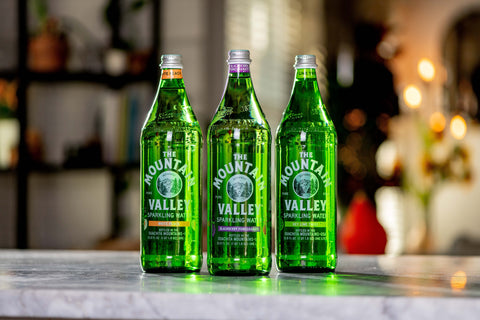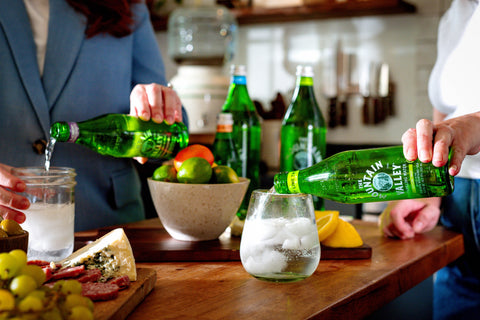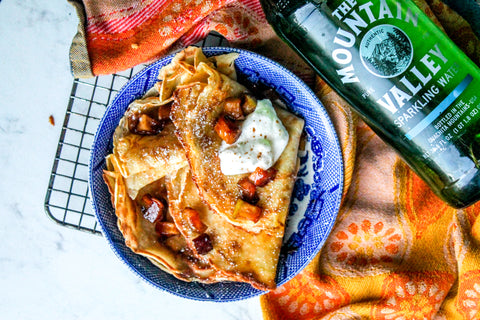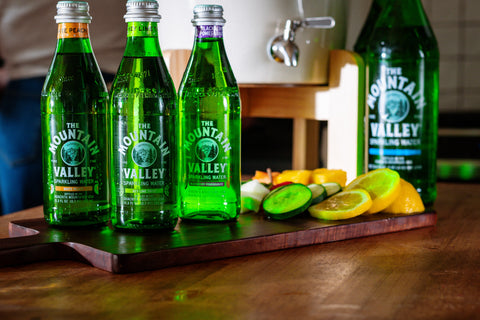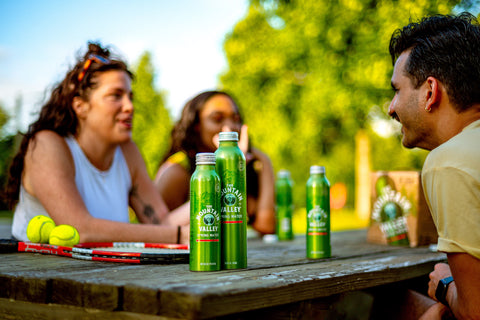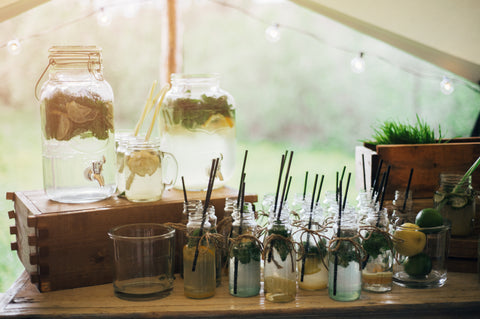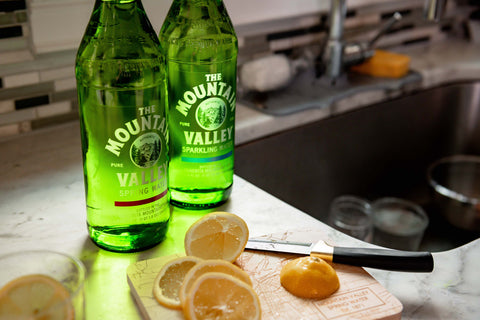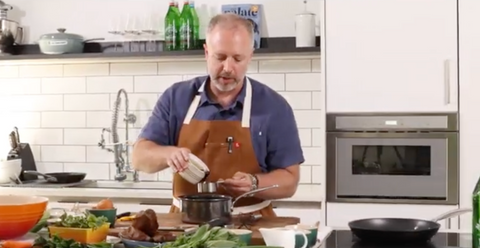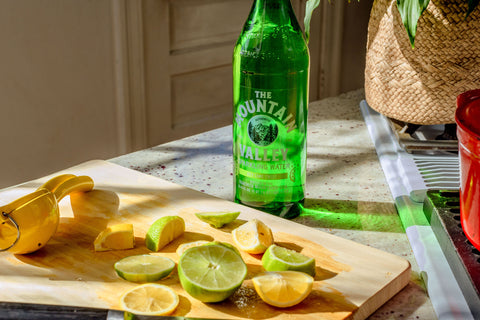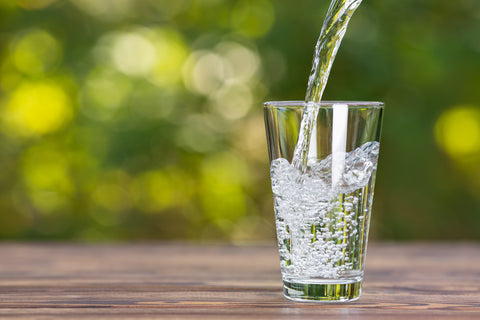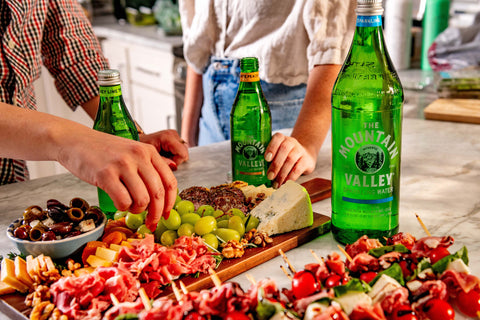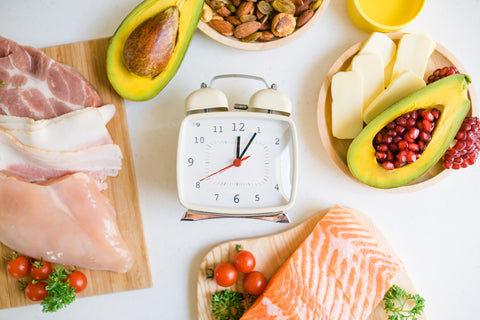
Summertime, and the livin’ is — HOT. Really, really hot.
As temperatures rise, hydration becomes all the more important. The best and simplest way to stay hydrated: drinking plenty of water. Water is crucial for replacing lost sweat, lubricating joints, flushing waste from cells and keeping the body cool and healthy.
But what happens if you get a bit bored with water? Can you drink your water, keep it fresh and healthy, and savor it, too?
Yes. The solution: fruit-infused waters.
These simple, refreshing concoctions seem to be bubbling up all over Instagram — infusions of water with berries, cucumbers and even sprigs of herbs that look as purely refreshing as they taste. The beauty of fruit-infused waters: They take on all the sweet flavors of their infusers but few to none of the sugars or calories.
How do you make fruit-infused water? It’s as easy as it looks. And in the sweaty throes of summer’s heat, easy is good.
But first, let’s talk water.

How much water should you drink in a day?
The human body is more than 50% water. Water is what we’re made of.
Experts at the U.S. National Academies of Sciences, Engineering, and Medicine have determined that the average healthy adult living in a temperate climate should consume between 11.5 and 15.5 cups of fluids each day. These fluids can take many forms, from the milk in your morning cereal to the greens in your salad to the berries and peaches in your fruit bowl.
The purest and simplest type of hydration, however, is water. When it comes to drinking more water, tips and tricks abound. But a little infusion can go a long way.

How to make fruit-infused waters?
Scroll through social media long enough, and these colorful concoctions — crystal-clear waters brimming with juicy berries and bright fruits — are sure to capture your attention. They look fanciful, but fruit-infused waters couldn’t be simpler.
While there are plenty of pricey contraptions and highly specialized bottles that promise to make fruit-infused waters a breeze, the process is just as easy without them. All you need: a vessel, some water, some fruit and some time.
The simplest way to infuse water with fruit is to combine the two and let them sit. With sliced lemons, limes and other juicy citrus fruits, infusions can be done in minutes. Fresh herbs and denser produce, such as cucumbers or apples, need a bit more time — a few hours or even overnight.
Much of infusing water is merely common sense. The longer the infusion lasts, the stronger the flavors will be. This is true of the sweet flavors of fruits and vegetables, and also of the bitter and acidic ones. To make the most of your fruit-infused water, time is of the essence.
Fruit-infused water recipes: How long to infuse?
How long the produce should infuse depends on the produce. Strongly flavored fruits, such as lemons and limes, don’t need much time. The simplest and quickest fruit-infused water recipe requires nothing more than a splash of fresh citrus — squeeze, stir, sip, and that’s it.
If allowed to infuse for too long, citrus fruits can impart bitter flavors to the water. The white piths of citrus rinds can be especially acrid. Many infused-water recipes advise removing citrus slices after two to three hours to avoid this bitter fate. Some say to omit citrus rinds altogether and stick to the fruits’ sweetly pulpy flesh.
Soft fruits, such as watermelon, mango and kiwi, also infuse quickly. If left in the water too long, these fruits can go mushy and will be more difficult to strain.
Berries, peaches and pineapples fall somewhere in the middle. They can tolerate longer soaks without falling apart or going bitter, or they can be removed sooner for a lighter, more subtle flavor.
Heartier fruits and vegetables — apples, celery, carrots — require more infusion time. These ingredients can infuse for overnight or even up to 12-18 hours.
Fruit-infused water recipes: Don’t forget the veggies
While most recipes dub these drinks “fruit-infused waters,” vegetables and herbs can also play delicious roles.
From the crisp flavors of cucumbers, carrots and celery, to the complexities of lavender, mint and parsley, to the thrumming warmth of ginger and jalapenos, vegetables add character, nuance and depth to infused waters, and they’re a lot of fun to play around with.
When working with dense vegetables, such as carrots, be sure to cut them thinly. More surface area means more flavor infusing into the water.
With strongly flavored vegetables, the gingers and the jalapenos for example, a little will last. These ingredients can be removed after a few hours to avoid them dominating the drink or becoming overwhelming.

Fruit-infused water recipes: Size matters
For faster, more flavorful infusions, thinly sliced fruits and vegetables are key. Thinner slices have more surface area, and more surface area means more opportunities for the produce to seep into and permeate the surrounding water.
For longer infusions, however, slightly thicker cuts of fruits and vegetables may make more sense. Larger slices are less likely to go mushy or disintegrate. They can better withstand long soaks, while still imparting their fresh flavors into the water.
When infusing water with herbs, many recipes suggest gently bruising or pressing the herbs first to help release the essential oils within the stems and leaves. Tearing the leaves prior to infusing also helps release these flavors.
Fruit-infused water recipes: Temperature matters, too
Most recipes suggest infusing fruit into cold water to allow the flavors to develop slowly and more robustly. While hot water is never advised — heat can destroy the subtleties and sweetness of the fruit — room-temperature water can speed up the infusion process.
For a faster fruit-infused water, allow the ingredients to steep in lukewarm water on the kitchen counter for two to four hours before serving it over ice, if desired.
For a slower, more rounded infusion, steep the ingredients with ice and cold water in the refrigerator for up to 12 hours. The cool climes of the fridge will keep the fruit fresh and flavorful for longer, preventing off flavors from permeating your beverage.
Fruit-infused water recipes: Can you use frozen fruit?
For the best fruit-infused water, fresh fruit is much better than frozen. During the freezing process, ice crystals puncture the cell walls of fruits, turning the fruits from firm and solid into something much softer and more malleable.
While frozen fruits can be used in a pinch for fruit-infused waters, they will often disintegrate quickly, turning to mush before their flavors can properly steep into the surrounding liquid.
Fruit-infused water recipes: Can you eat the fruit following the infusion?
You sure can, but don’t get too excited about it. After hours submerged in water, the fruit won’t be nearly as tasty or colorful as fresh fruit. The infusion process leeches much of the flavor, nutrients and, yes, even the color from the slices and bits of fruit. That’s great news for your water but less so for the pulpy, leftover fruits. What’s left behind will be rather bland, although they’re still a decent source of fiber and some vitamins.
Waste not, want not.

Fruit-infused water recipes: What’s the best container for infusing water?
For single-serving or smaller portions, mason jars will work just fine, as will pint glasses topped with plastic wrap — but that last part is fairly important. Some type of lid or barrier, such as plastic wrap, will prevent off flavors from joining the fruity infusions in your water.
This is especially crucial when infusing water in the fridge. The last thing you want is for scents from a nearby roast turkey or tuna salad to ruin your refreshingly fruity beverage.
For larger servings, a pitcher will work nicely. But again, make sure it has a lid of some sort to keep the water at peak deliciousness.

Fruit-infused water recipes: And now, the recipes
The best fruit-infused waters don’t require hard-and-fast recipes so much as they require techniques. For every two to three cups of water, allot approximately ¼ to ⅓ cup of fresh fruit. For quicker results, slice your fruits thinly or cut them into small chunks. To avoid bitterness from citrus, be sure to cut away the piths and rinds of those fruits, or set a timer to remove the citrus after an hour or two.
While you can leave the fruits in the water for as long as you like, it’s best to strain or remove them after 12 to 18 hours so they don’t start to decompose. This will keep your fruit-infused water drinkable for longer, up to three or four days if refrigerated throughout.
As for what to infuse your water with, your imagination is the limit.

Here are three of our suggestions:
Recipe: Fruit-infused water with strawberry, basil and lemon
Serves 4
Ingredients
- 5 cups Mountain Valley Spring Water
- 1 cup ice
- ½ cup cleaned, sliced strawberries
- 5-8 torn and bruised fresh basil leaves
- 1 lemon, sliced thinly
- For garnish (optional): 4 fresh, whole strawberries; 4 sprigs basil
Directions
- Add ingredients to a large pitcher, then top with ice and water. Infuse in the refrigerator for 2 to 3 hours.
- Remove the lemon slices and allow the remaining fruit to steep for 2 to 3 more hours or overnight.
- Strain/remove remaining produce before serving.
- Garnish each glass with a fresh berry and basil sprig before serving, if desired.
Recipe: Fruit-infused water with mango, mint and ginger
Serves 4
Ingredients
- 5 cups Mountain Valley Spring Water
- 1 cup ice
- ½ cup mango
- 5-8 torn and bruised leaves of fresh mint
- 2-inch nob of fresh ginger, peeled and sliced
- For garnish (optional): 4 sprigs of fresh mint
Directions
- Add ingredients to a large pitcher, then top with ice and water. Infuse in the refrigerator for 2 to 3 hours.
- Remove the sliced ginger and allow the remaining fruit to steep for 2 to 3 more hours or overnight.
- Strain/remove remaining produce before serving.
- Garnish each glass with fresh mint before serving, if desired.
Recipe: Fruit-infused water with cucumber, orange and jalapeño
Serves 4
Ingredients
- 5 cups Mountain Valley Spring Water
- 1 cup ice
- ½ cup sliced cucumber
- ½ small jalapeno, seeded, deveined and cut into thick slices
- 1 small orange, sliced
- For garnish (optional): 4 slices of fresh cucumber
Directions
- Add ingredients to a large pitcher, then top with ice and water. Infuse in the refrigerator for 2 to 3 hours.
- Remove the jalapeño and orange slices, then allow the remaining produce to steep for 2 to 3 more hours or overnight.
- Strain/remove ingredients before serving.
- Garnish each glass with fresh slices of cucumber, if desired.








